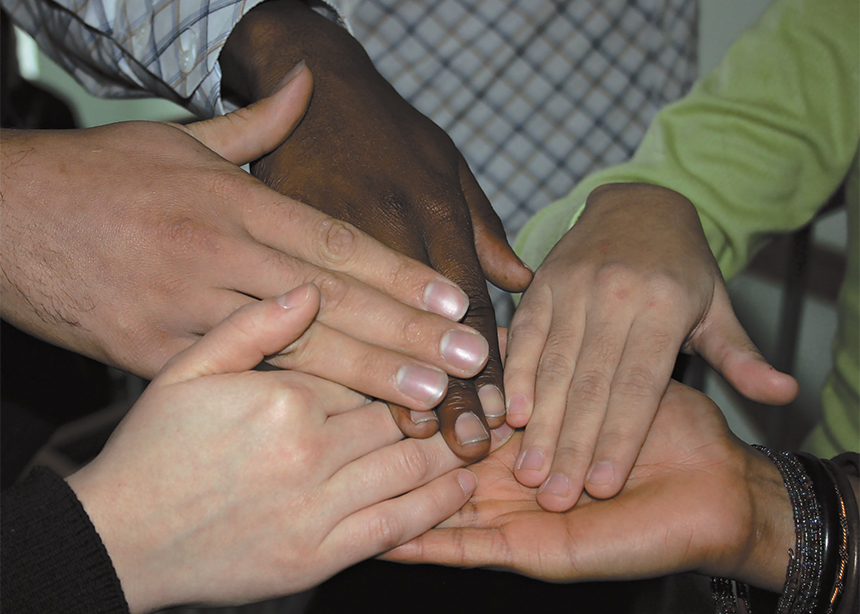 By Doug Klassen
By Doug Klassen
During times of crisis or struggle, I study Scripture, praying that the Holy Spirit nudges me with a word, a phrase . . . anything. A few months ago, I came upon Acts 11:19-26 and I knew that I had received an answer to a question I had wrestling with: Where is God leading us as a nationwide community of faith, as regional churches and as local congregations?
After the stoning of Stephen in Jerusalem, the followers of Jesus scattered. Some went as far as Antioch, in Syria. While some spoke the message of Jesus only with other Jews, others began to proclaim him to the Hellenists (Greeks). God blessed this effort and their numbers grew rapidly.
News of this came to the ears of the church in Jerusalem, and they sent Barnabas to Antioch to inspect. He rejoiced and then went to Tarsus to look for Saul to help. When Barnabas found him, he brought Saul to Antioch. They stayed together for a year, teaching and preaching to a great number of people. It was in Antioch that the disciples were first called Christians.
In my ongoing task of reviewing church policies and structures, sometimes it feels like I am in Jerusalem: guarding cultural ways of being church and straining out the gnats (Matthew 23:24). Meanwhile, Barnabas is taking Saul to Antioch (Acts 11:25). For me, it’s clear the church is heading to an expression similar to Antioch of old. It was in Antioch that the church underwent a fundamental transformation and erupted with new opportunities inspired by the Holy Spirit. Antioch is intercultural, multilingual, and multiracial; it is cosmopolitan.
In the 20th century, as the Mennonite church formalized relationships with governments, churches and conference bodies were incorporated under Canadian societies act legislation. To comply, we adopted governance practices like forming boards, and hosting annual general meetings where financial statements were passed using Robert’s Rules of Order. We wrote bylaws, constitutions and policies, and made our confessions of faith our identifier.
I am very thankful for the careful thought that went into the ways that we have historically organized. Those actions gave us the ability to control, clarify and systematize how we lived as church in that time. But in Antioch, all of that is secondary to meaning, purpose and belonging. Relationship replaces structure, and encounter replaces apologetics.
Today, Mennonite Church Canada is exploring what it means to become an intercultural church. Guiding us in this is the multiethnic Intercultural Church Steering Committee, made up of members from across our nationwide church community.
At our first meeting this past February, I proudly shared my Antioch analogy, and then we began sharing our hopes, dreams and questions.
Joon Park, a member from Mennonite Church British Columbia, responded first by asking me, “Why now?” Excitedly, I said that diversity was written into the church’s 2017 structure documents. Also, I added, my own experiences with intercultural church had changed me. I was shocked when he replied, “I wrote about the church in Antioch 10 years ago and no one showed any interest.”
After the meeting, Joon circulated a paper he had written while in seminary. In it, he quoted as his inspiration Mark Deymaz in his seminal book, Building a Healthy Multiethnic Church: “[In Acts 13:1] Luke has listed the five leaders of the church at Antioch not only by gifting and role, but, [significantly] by ethnicity as well. Surely, it is more than coincidental that two of these men were from Africa, one was from the Mediterranean, one was from the Middle East, and one was from Asia Minor! . . . Such indirect prescription is informative for the church today and, certainly, for the multiethnic [intercultural] church. . . .”
I was humbled and realized that, in the months ahead, I needed to listen. The Holy Spirit has been lifting these Antioch truths out of Scripture for new Canadian Mennonites for years, and I—we—did not notice.
 By Joon Park
By Joon Park
Yes, the story of Antioch is not only descriptive of how the early church was multiethnic, but is also prescriptive for modern churches, including the Mennonite church, churches which have become comfortable with homogeneity. Unfortunately, even though the Antioch church was built in AD 42, and almost two millennia have passed, Luke’s dream for the multiethnic church is still largely unfulfilled.
It is true that churches that were once composed of people of only one ethnicity are now, intentionally or unintentionally, becoming heterogeneous, multiethnic and multicultural. Canadian Mennonite churches are not an exception. German-speaking congregations have dwindled, and new immigrants and refugees have been welcomed into the family: Hmong, Karen, Afghan, Indian, Korean, Congolese, Syrian, Ethiopian, Kenyan, Colombian, Brazilian. Whew!
However, even though the Mennonite church appears multicultural, the majority of Mennonites still fall behind in embracing the true meaning of multiculturalism and applying it practically to their congregations. It is one thing to agree cognitively that the 21st century is an era of accommodation and adaptation, but it is another to embrace and embody a new multicultural reality.
It is my experience that there are still unexpressed or undefined sentiments felt by white Mennonites about losing their original Anabaptist identity when they are challenged by intercultural encounters. This often reinforces a stereotype that “the best person for the job” is like us (by colour or last name). This attitude hampers our journey to become a more inclusive, intercultural church.
Flashback
As a Korean Christian, I knocked on the door of a Mennonite church in Vancouver in 2004. With the belief that I would be well cared for and treated as I was in the Korean church, I started attending regularly. As weeks went by, I discovered that no one would initiate conversation with me.
Crestfallen by this German restraint and reservation, I hid away as soon as the Sunday service was adjourned, not attempting to say hello to modern-day Anabaptist descendants. My mind clouded with the questions:
- How can I break through this cultural or ethnic barrier with the Mennonites?
- How can I help the Mennonites cope with this kind of accidental encounter with a stranger?
- How can God intervene and, if so, what can God say in a situation where nobody dares reach beyond cultural barriers?
Seventeen years have passed since I officially became a member of a Mennonite church. I studied Anabaptist theology at Anabaptist Mennonite Biblical Seminary in Elkhart, Ind., and finally came to preach at a pulpit in a traditional Mennonite sanctuary. Yet I still have no clear answers to my questions, no clear answer to my identity as a “validated” Mennonite.
Back to Antioch
Why was the leadership of the Antioch church composed of people of multiple ethnicities? What was Luke’s intention in mentioning those believers’ names along with their country of origin?
I believe Luke meant to reflect the demographics of Antioch, the cradle of cultures and peoples, and its multiculturalism, the place where the Christian church was born and breathed the air of multicultural, multiethnic passion and potential. Luke believed the church community inside the walls should represent the community outside the walls. People from different cultural and ethnic backgrounds made up the leadership of the church, started a new church plant and, finally, sent the first Christian missionaries into the world. This happened not from Jerusalem, the centre of Jesus’ original disciples.
Luke was wise enough to predict that this experimenting, multicultural and multiethnic church would experience bumps and bruises on the way—the relationship between Paul and Peter became damaged, the tensions between Jews and Gentiles escalated, Paul and Barnabas separated, and the church itself did not last. But Luke’s evangelical zeal was unshaken; he knew that, through it all, the Lord would be faithful. People of all colours would be blessed to be part of the plan for the flourishing of the church.
Antioch now
Luke’s unfulfilled Antioch mission of the multicultural, multiethnic church is now assigned to us. It is not a matter of choice. It is a holy mandate from God for us to embrace here and now.
We know from the Antioch example that it will not be easy and there may be no certainty or security ahead of us. This is a road less travelled, yet worth exploring because we are guided by the Holy Spirit, who was there in Antioch. We are equipped by our collective, unswerving intentionality, not through random prayer or wishful thinking.
What are we afraid of? Let us now, instead, dream a big dream that people from all walks of life, regardless of ethnic differences, will gather as one body, singing praise to the Lord, “Salvation comes from our God who sits on the throne and from the Lamb!” (Revelation 7:10). O holy and heavenly multicultural, multiethnic humanity!
Joon Park is an intercultural educator and author. He attends Emmanuel Mennonite Church in Abbotsford, B.C.
Doug Klassen is the executive minister of Mennonite Church Canada. He attends Sterling Mennonite Fellowship in Winnipeg.
For discussion
1. Have you ever paused to wonder where God is leading us as congregations of Mennonite Church Canada? What future do you see for the Mennonite church? What things make you anxious about the future and what things give you hope?
2. In the days of the early church (Acts 11: 19-26), how was the church at Antioch different from the church at Jerusalem? What persuaded Barnabas to welcome Greeks into the church? What questions do you think the people of Jerusalem had for Barnabas? Who is acting as a Barnabas in today’s church?
3. Doug Klassen, the executive director of MC Canada, writes that he believes God is leading us to become an intercultural, multiracial and multilingual church. Do you agree? What is exciting about the church becoming intercultural and what is intimidating?
4. Joon Park writes that, in his experience, white Mennonites tend to fear losing their Anabaptist identity when they are challenged by intercultural encounters. Do you agree? What needs to happen for a church to become truly intercultural?
5. Park says that being a multicultural and multiethnic church is “a holy mandate from God.” What are the signs that show this is true? What might MC Canada look like in 20 years?
—By Barb Draper









Leave a Reply
You must be logged in to post a comment.